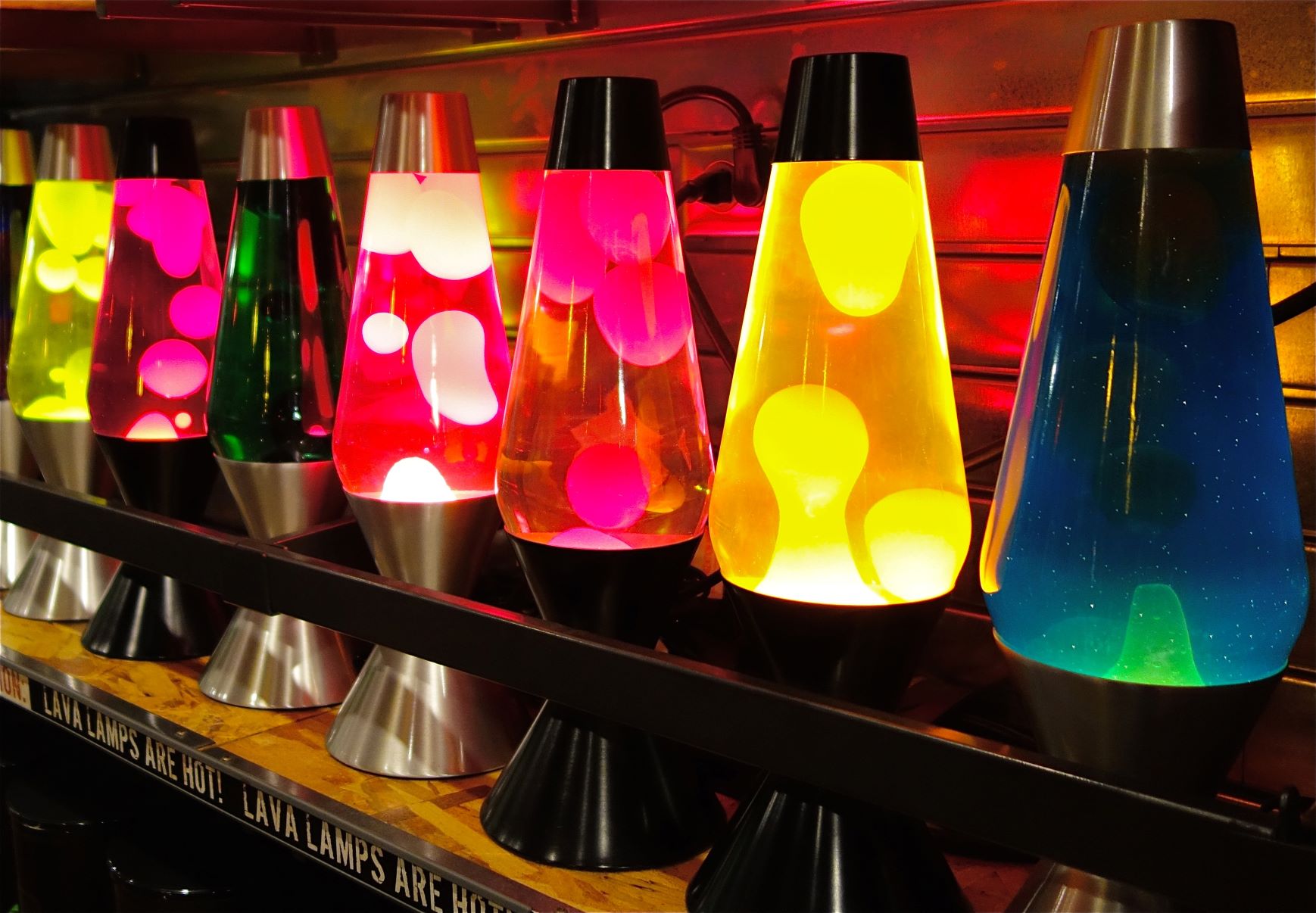
Lava lamps have been a popular decorative item for decades, captivating both young and old with their mesmerizing flow of liquid and vibrant colors. These iconic lamps not only add a touch of retro charm to any space but also serve as a conversation starter. But how much do you really know about lava lamps? In this article, we will dive into the fascinating world of lava lamps and explore 20 intriguing facts that will surely ignite your curiosity. From their humble origins to their undeniable cultural impact, join us as we uncover the secrets behind these quirky and unique lighting fixtures. So, sit back, relax, and prepare to be enlightened about the intriguing world of lava lamps!
Key Takeaways:
- Lava lamps, invented in the 1960s, are not only mesmerizing and relaxing but also serve as unique decorative pieces, stress relievers, and conversation starters for any space.
- With their colorful, flowing wax and retro appeal, lava lamps have made a comeback in recent years, captivating people of all ages and becoming symbols of individuality and self-expression.
The Invention of the Lava Lamp
The iconic lava lamp was invented by Edward Craven Walker, a British accountant, in the 1960s. Walker was inspired by an egg timer he saw in a pub, which led him to experiment with ways to create a mesmerizing and relaxing lighting display.
Psychedelic Origins
Lava lamps became popular during the psychedelic era of the 1960s and 1970s. Their colorful, flowing blobs of liquid helped create a trippy atmosphere that resonated with the counterculture movement of the time.
The Lava Lamp’s Unique Chemistry
Lava lamps contain a mixture of colored wax and a clear or translucent liquid, usually water or a mineral oil. The wax is heated by an incandescent bulb at the base of the lamp, causing it to rise to the top and create the mesmerizing lava-like effect.
The Purpose of the Stylish Bottle
The bottle of a lava lamp is designed to enhance the flow and movement of the wax. The shape of the bottle, along with its heat-resistant material, ensures the perfect balance between viscosity and mobility.
Lava Lamps and Ambient Lighting
Lava lamps are often used as ambient lighting in homes, offices, and other spaces. Their gentle, soothing glow creates a relaxing atmosphere and can help reduce stress and anxiety.
Countless Colors and Designs
Lava lamps are available in a wide array of colors and designs, allowing individuals to choose the perfect one to match their personal style and decor.
Lava Lamps for Different Purposes
While lava lamps are primarily used for decorative purposes, they can also serve as a unique and artistic lighting source for parties, events, and themed gatherings.
Lava Lamps as Conversation Starters
The mesmerizing flow of a lava lamp often becomes a topic of conversation among guests, making it a great icebreaker for social gatherings.
Lava Lamps and Stress Relief
Watching the slow, rhythmic movement of the wax in a lava lamp can be a form of visual therapy, promoting relaxation and helping to alleviate stress.
The Lava Lamp’s Popularity Resurgence
In recent years, lava lamps have experienced a resurgence in popularity, thanks to their retro appeal and vintage aesthetic that has made a comeback in contemporary design trends.
Collector’s Items
Some lava lamps produced in the past have become highly sought-after collector’s items, especially those from limited editions or with unique designs.
Lava Lamps in Popular Culture
Lava lamps have made appearances in various movies, TV shows, and music videos, further solidifying their status as pop culture icons.
Experimenting with Different Temperatures
Changing the temperature can affect the behavior of the wax in a lava lamp. Cooling the lamp down can slow down the movement, while heating it up can create more vigorous flows.
Substitutes for Wax and Liquid
While the traditional lava lamp uses a combination of wax and liquid, some modern variations use different materials like glitter or metallic particles to create unique visual effects.
Lava Lamp Feng Shui
According to some belief systems, placing a lava lamp in the wealth corner of a home or office can help attract positive energy and abundance.
Lava Lamps and Retro Décor
Lava lamps are often used as key elements in retro-themed interiors, adding a touch of nostalgia and authenticity to the overall design.
Customizing Lava Lamps
There are DIY kits available that allow individuals to create their own personalized lava lamps, providing a fun and creative activity for enthusiasts.
The Lava Lamp’s Cultural Impact
The lava lamp has become a symbol of the 1960s counterculture movement, representing individuality, self-expression, and a break from traditional norms.
Lava Lamps and Mindfulness
Some individuals use the gentle motion of a lava lamp as a focus point during mindfulness and meditation practices, enhancing relaxation and inner peace.
Endless Entertainment
Watching the ever-changing patterns and formations of wax in a lava lamp can provide hours of entertainment and fascination.
Conclusion
These 20 lava lamp facts give us a fascinating glimpse into the history, science, and popularity of these iconic décor items. From their invention in the 1960s to their continued appeal today, lava lamps have captivated people with their mesmerizing motion and warm glow. Whether you are a fan of retro aesthetics or simply appreciate the calming effect of liquid motion, a lava lamp can bring a unique ambiance to any space.
With their fluid dynamics, colorful options, and wide range of sizes, lava lamps have become more than just quirky accessories; they are statement pieces that add character to homes, offices, and even dorm rooms. So next time you come across a lava lamp, you’ll be armed with interesting facts that can make for great conversation starters at your next gathering!
FAQs
1. Who invented the lava lamp?
Florence “Flo” Craver, an English entrepreneur, is credited with inventing the lava lamp in 1963.
2. How does a lava lamp work?
A lava lamp consists of a glass container filled with a mixture of wax and a liquid, typically a transparent solution. When heated from beneath by a light bulb, the wax melts and rises to the top, creating mesmerizing blobs that float and undulate as they cool and fall back down.
3. Are lava lamps safe to use?
Lava lamps are generally safe to use if you follow the instructions provided by the manufacturer. However, it’s essential to keep the lamp away from flammable materials, avoid touching the lamp when it’s hot, and never shake the lamp as it can damage the internal components.
4. Can I change the color of the liquid in a lava lamp?
Some modern lava lamps allow you to change the color of the liquid. You can also experiment by combining different colors to create unique visual effects.
5. Can I use a lava lamp as a night light?
Yes, lava lamps can serve as a soothing night light due to their soft glow. However, it’s important to ensure the lamp is placed on a stable surface and out of reach from children or pets.
Was this page helpful?
Our commitment to delivering trustworthy and engaging content is at the heart of what we do. Each fact on our site is contributed by real users like you, bringing a wealth of diverse insights and information. To ensure the highest standards of accuracy and reliability, our dedicated editors meticulously review each submission. This process guarantees that the facts we share are not only fascinating but also credible. Trust in our commitment to quality and authenticity as you explore and learn with us.


